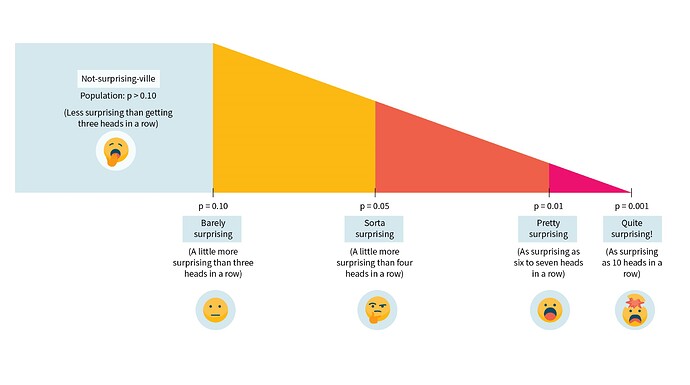Indeed. Perhaps as I get older, I might switch to step master/rowing machine to still get the cardio, but eliminate the impact. Although I am super motivated, currently on treadmilll, unless I press the stop button, I have no choice but to keep running vs slowing down with other machine types. Keeps me honest. So just like eating, if you keep your hand away from your mouth, you eat less.
This is a really good episode from Peter Attia that outlines his thinking on reading studies.
another good thing to be “up” on:
The p -value is a number between 0 and 1 that indicates how surprising a study’s results would be if there was actually no effect. The lower the value, the more reason you have to suspect the results are “real”, as long as the study and statistical analyses are well-designed.
There’s more to the p-value than the null hypothesis
In this article, we are focusing almost entirely on a single core assumption needed when calculating a p-value: that the intervention makes no difference. As we said in the text, a null hypothesis presumes that the intervention being studied has no effect. However, this isn’t the only assumption that needs to be made to compute a p-value — how the data behave, how the data were collected, and what choices were made in analyzing and presenting the data all play a role. And if any of these assumptions are wrong, the p-value can be misleading.
Consider adding
Nootropics
PT-141
BP-157
FMD - Fasting Mimicking Diet
CIMT
carotid intima-media thickness test ?
Yes sir! Non invasive and decent literature behind it.
There seems to be some disagreement on CIMT:
From Peter Attia’s recent AMA on Heart Disease:
How can CIMT (carotid intima media thickness) be helpful in understanding ASCVD?
- CIMT is an ultrasound that’s done of the carotid arteries in the neck
- Peter finds this to be a completely unhelpful test for a couple of reasons:
- 1 – It is so user dependent in terms of the operator
- The operator needs amazing technical skill to get a really good look at those carotid arteries
- 2 – If you will want to see a change in this, you pretty much have to have the same person doing it again and again.
- This might be that this is helpful if you have major, major carotid stenosis
- Evenstill, Peter would still prefer to to a CTA in this situation
- There are no guidelines that are based on a CIMT
- People look to this test because it has no radiation, but the CAC has virtually no radiation
“I don’t see an advantage of CIMT over CAC ”— Peter Attia
- Interpreting results of CIMT can be confusing
- A negative CIMT doesn’t tell much; it’s easy to miss things here
- Obviously if there is a lot disease in the carotid artery, the CIMT will show it
Peter prefers a CAC over a CIMT
butylated hydroxytoluene (BHT), showed a whopping 30% life extension in a study from 1979. Very quiet since. Cheap as chips, if there is some new info on this, it would be great to catch it.
Glycine and NAC, will be interesting to follow.
Interesting:
and from here:
The Database of Ageing-related Drugs
https://genomics.senescence.info/drugs/drug_details.php?compound_name=Butylated%20hydroxytoluene
Will add it to my watch list.
I wonder if its the whole issue around people not publishing negative results… perhaps there was another lab that tried to duplicate this, couldn’t and gave up (and of course, this type of thing gets discussed at the academic conferences, but never makes it out to the public at large)…
Of course - the entire list of compounds being tested in the NIA ITP program (that have not yet had results published) are good prospective candidates for anti-aging drugs to watch:
@RapAdmin - I really need to get better at using your tools to be a better responder.
Dr. Attia is awesome and a source of so many valuable resources. His comments are the classic response we see from most traditional, but not all cardiologist.
In short, I think CIMT gives me and many others a tool that Calcium Scoring Test do not. Standard responses to his responses are the follow
- A high percentage of pathology found in the carotid arteries can correlate with coronary after disease.
2.You need highly trained techs and cardiology/ vascular radiologist to read and follow - so find and use them
-
A Chest x-ray is about 0.1 msv vs. A Calcium Scoring CT is about 1.8 msv.
-
CIMT can see “soft plaque” not seen by Calcium Scoring and soft plaque are at more risk for rupture and stroke.
-
I start with CIMT and move to a calcium scoring test if needed - both triggered by an elevated risk and or abnormal advanced lipid testing - CRP, LpPla2, Lpa,
I google the full title of an article and can often find it online for download. If it shows up in researchgate there are often full text downloads. If not, authors usually share if I ask. I learn better from reading than from hearing so I avoid videos when I can. I do listen to audio on road trips. I download a lot of talks to my phone and listen when I drive. I live in the country and a drive to the city is about a two hour drive and I often pull over to note details for future reference.
Hi Vulcan, welcome to the forums. Thanks for sharing. I do the same as you when a new paper comes out. Lately I’ve also started seeing that many times the authors of the study post a private link on twitter to the paper where you can easily download it. It seems that many of the journals are now recognizing that study authors want to share papers with their friends (and they are also typically allowed to do this) and so the journals provide a private “author link” to the full paper - and this gets posted on twitter. So - just one more way to get access to papers.
If you come across papers that are relevant to our discussions here - you can drag and drop them from your computer to a post in this forum and add them for our discussions…
See example below from today:
Thank you. It looks like I need to become a twitter user.
If you want some papers and don’t have an access point from the channels you already mentioned - just prepare a running list of them (assuming it’s not a huge amount for my personal assistant to deal with) and let me know - I have access to 99%+ of the papers out there - I’ll be happy to share them privately for “academic/educational” reasons under “fair use”, as long as it’s not “abusive” amounts. I’m also assuming you’re not “sharing them publicly” and scrubbing my information from the files I’m sharing privately. I have enough asset protection to fight off and scare off the publishers even if there’s a tiny chance of a lawsuit (everyone has different rules for sharing and it becomes really stupid for scientific discussion) because the academic publishing industry just sucks balls and even a lot of open access is now for-profit.
As you are already aware, you can make a summary of the paper publicly (I think there are some tools to semi-automate this), so others can learn from it without violating copyright laws.
Why Sci-Hub exists:
Thanks for this renewing SciHib url.

